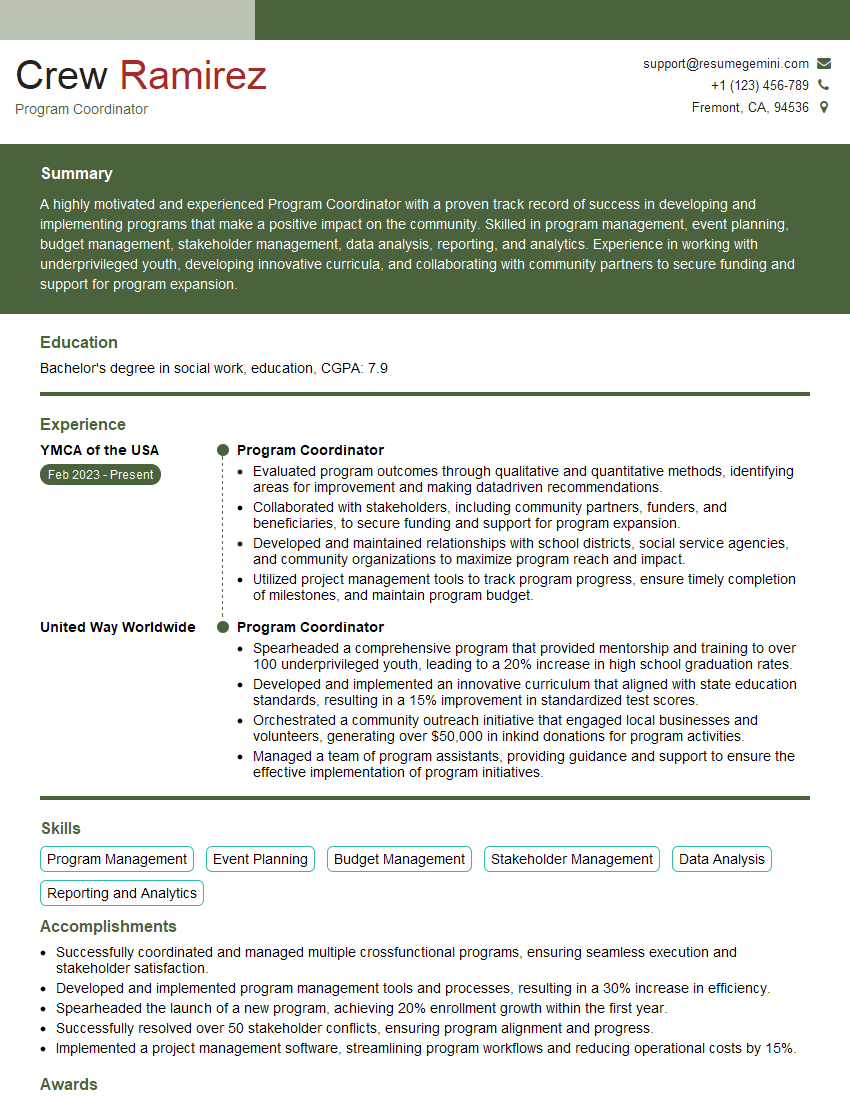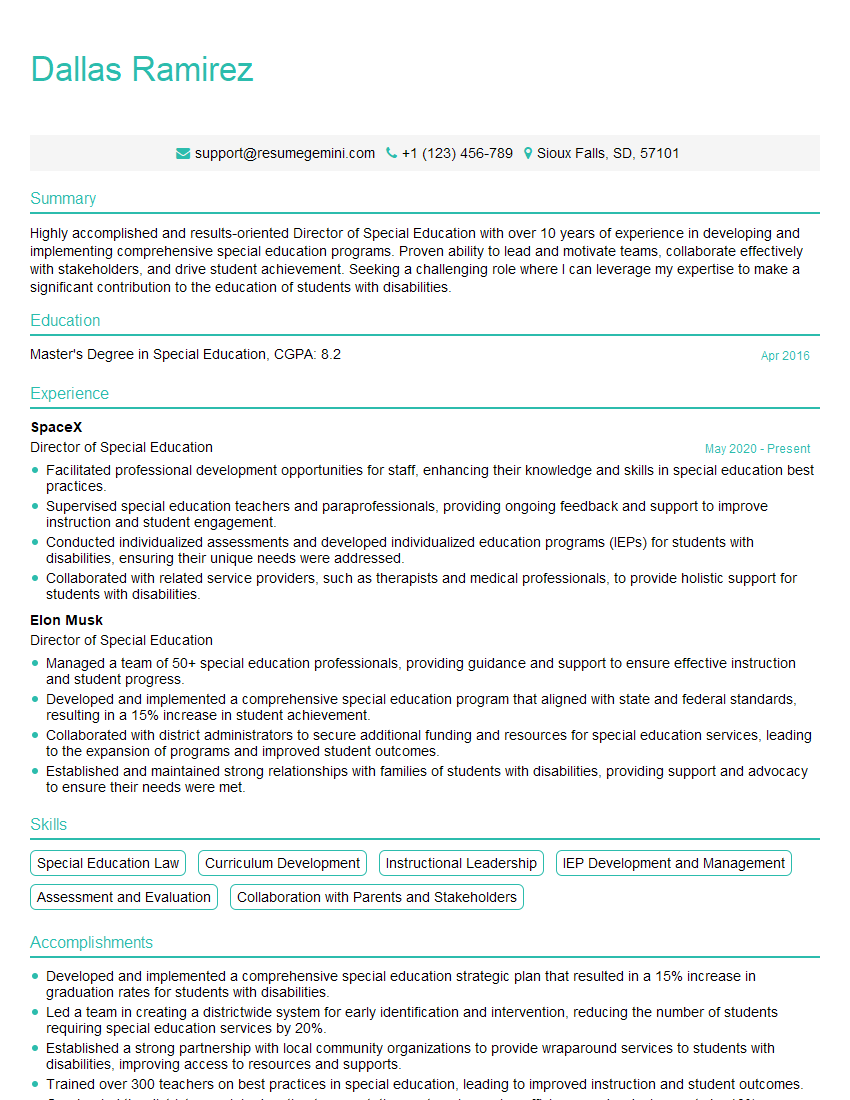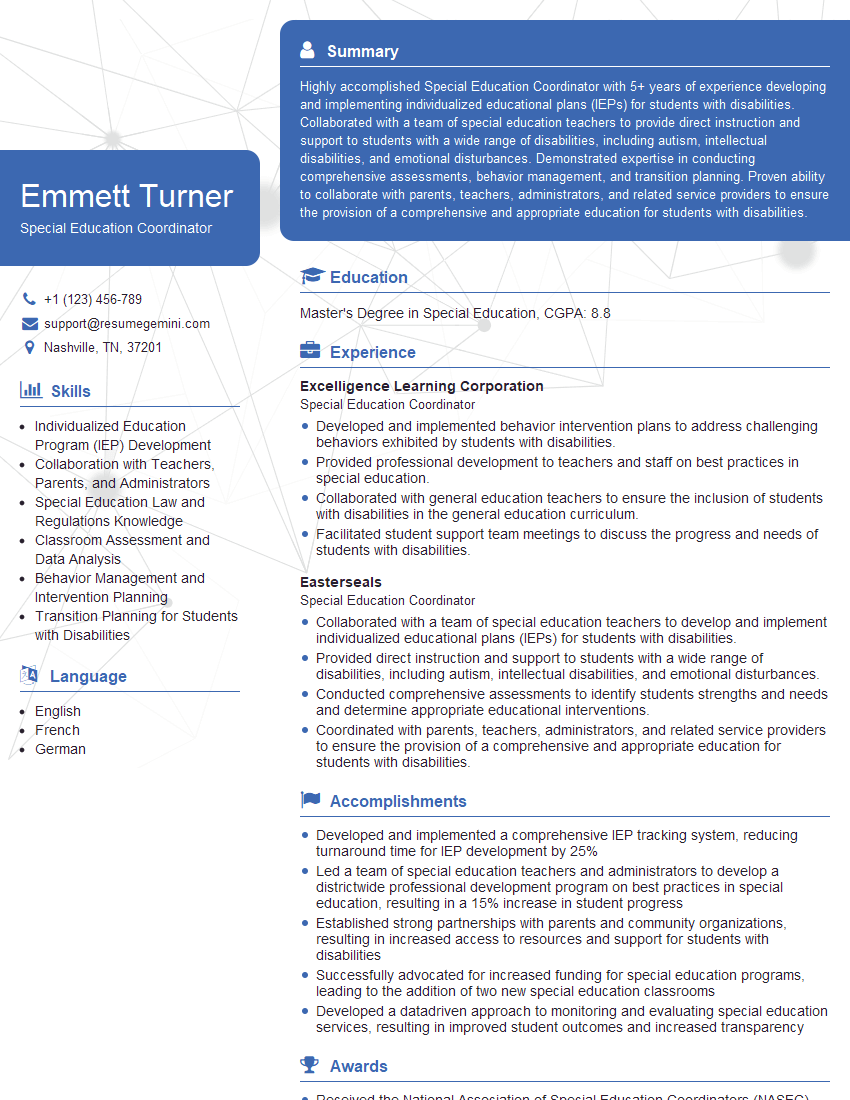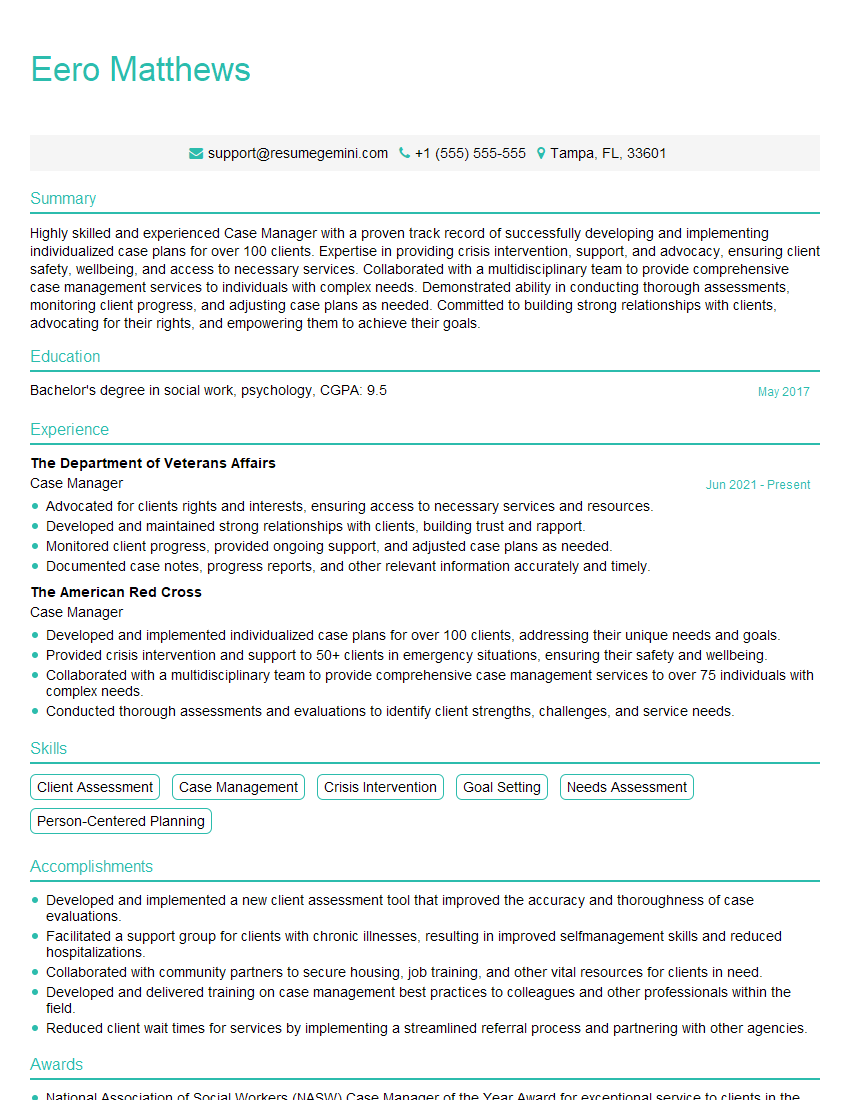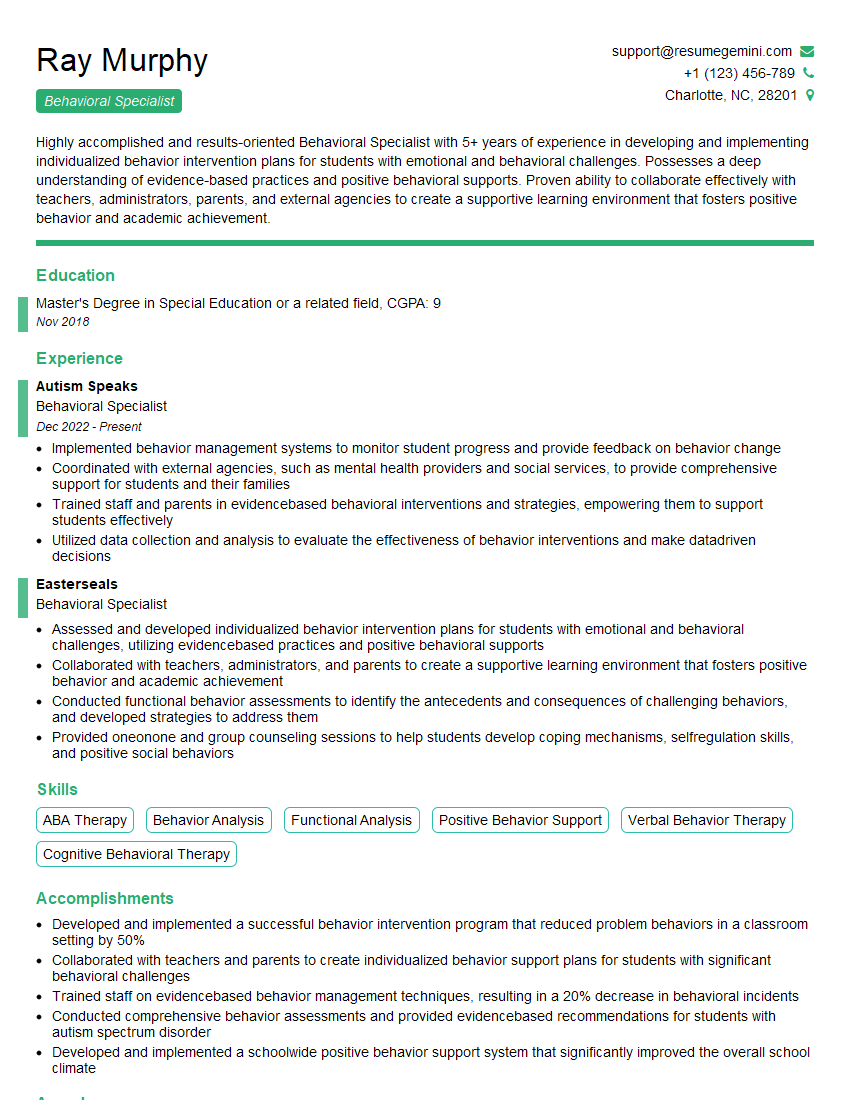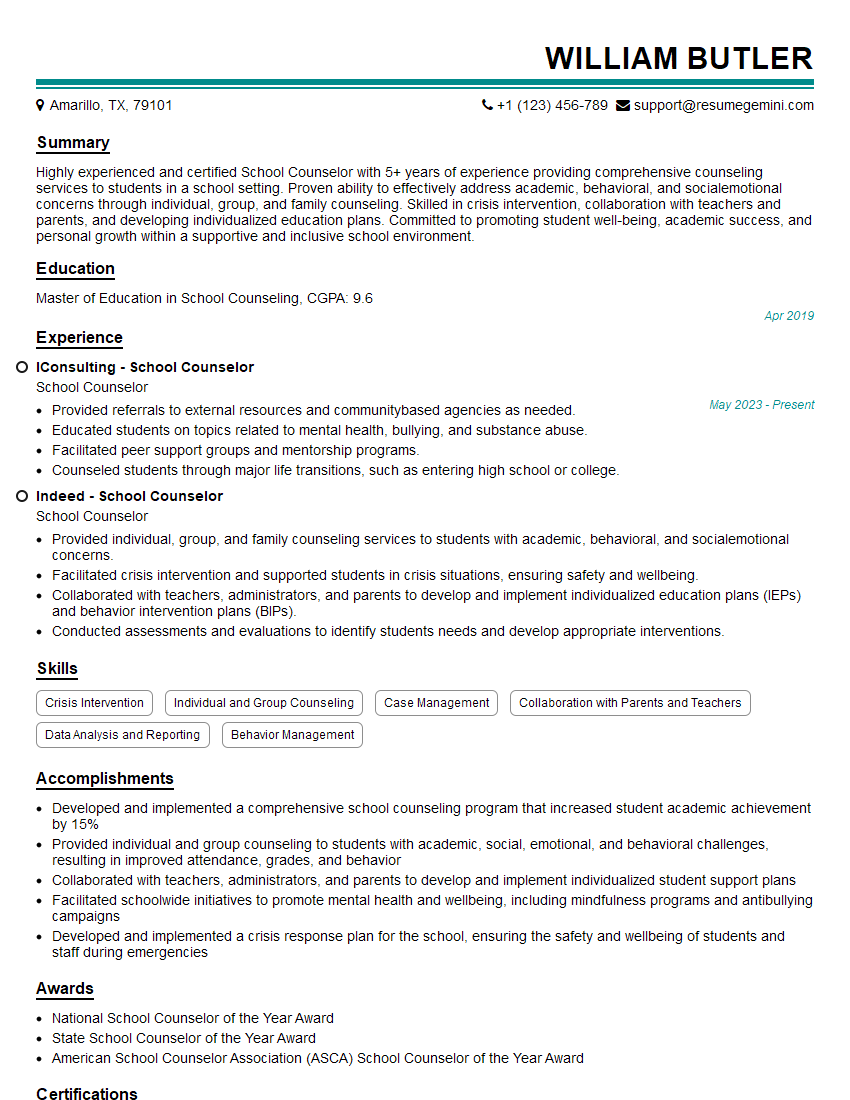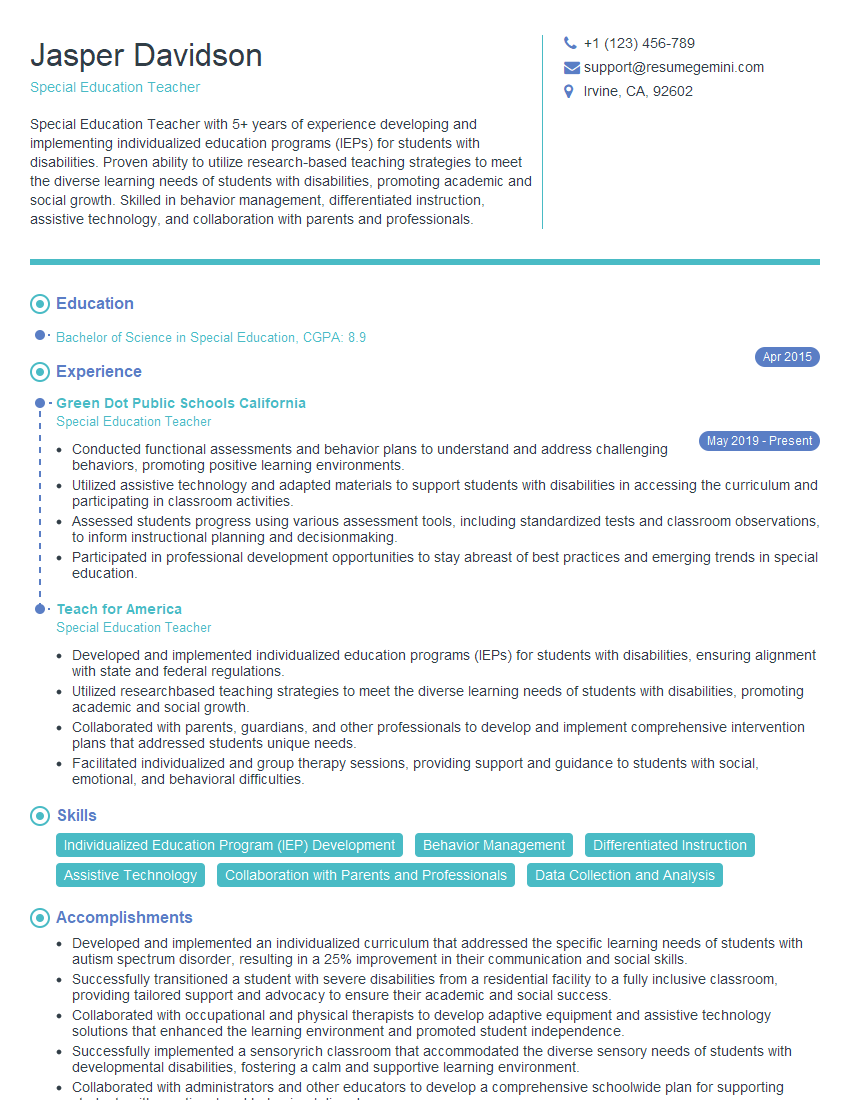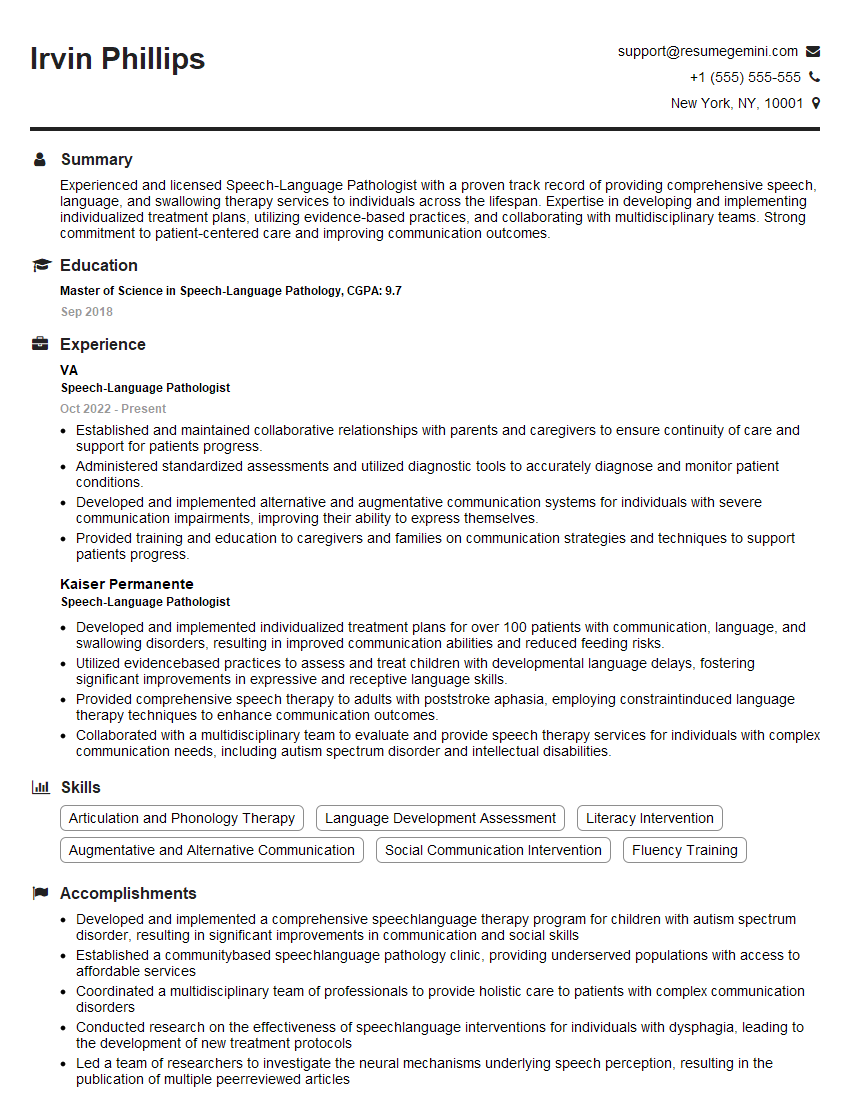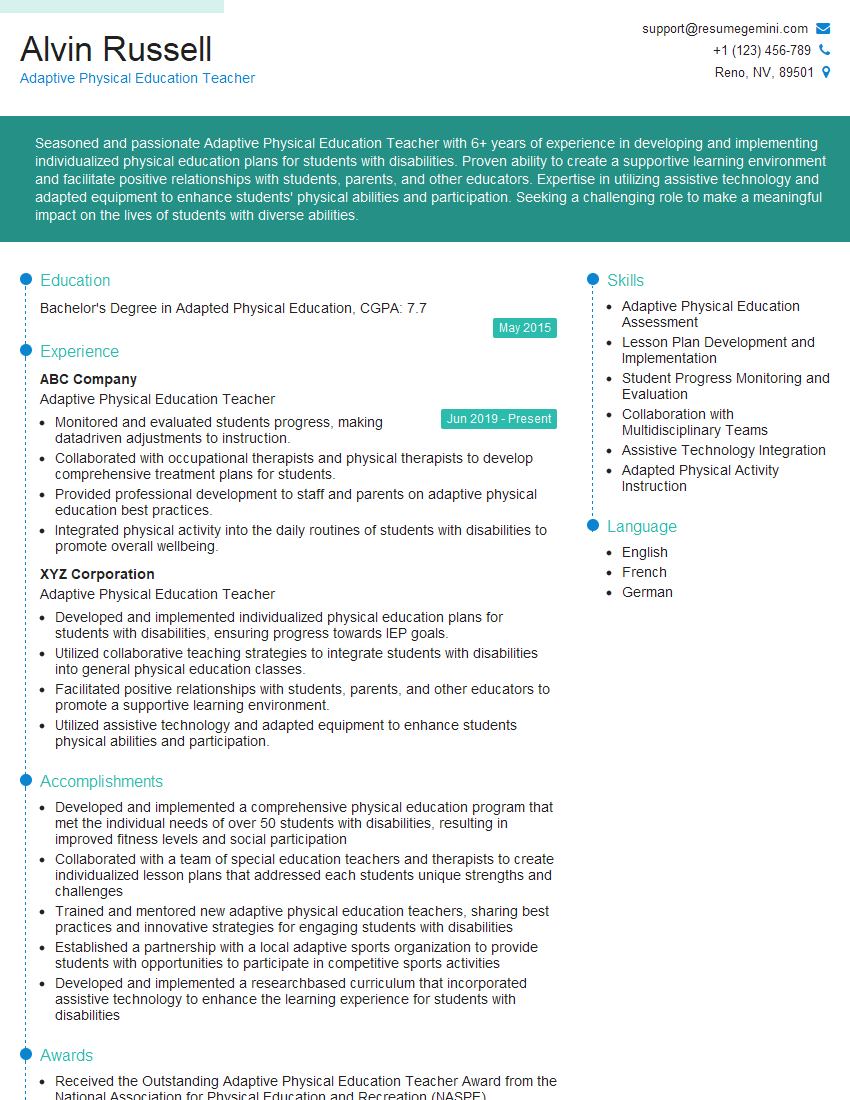Are you ready to stand out in your next interview? Understanding and preparing for Interdisciplinary Collaboration with Therapists and Educators interview questions is a game-changer. In this blog, we’ve compiled key questions and expert advice to help you showcase your skills with confidence and precision. Let’s get started on your journey to acing the interview.
Questions Asked in Interdisciplinary Collaboration with Therapists and Educators Interview
Q 1. Describe your experience facilitating IEP meetings.
Facilitating IEP (Individualized Education Program) meetings requires a nuanced understanding of legal requirements, individual student needs, and collaborative team dynamics. My approach centers around ensuring all participants – parents, educators, therapists, and administrators – have a voice and feel heard. I begin by establishing clear objectives for the meeting, reviewing the student’s current progress data, and outlining the agenda. I actively manage the discussion, ensuring equal participation while steering the conversation towards data-driven decision-making. For instance, I might use visual aids like graphs showcasing student progress across different academic areas to facilitate a shared understanding of strengths and weaknesses. I also ensure that parents feel empowered to participate fully, encouraging them to share their insights and perspectives on their child’s needs. Finally, I synthesize the discussion, collaboratively creating an IEP that is both legally sound and reflective of the team’s collective expertise and the student’s unique needs. This involves carefully documenting all agreed-upon goals, services, and accommodations.
Q 2. Explain your approach to conflict resolution within an interdisciplinary team.
Conflict resolution within an interdisciplinary team relies on fostering a culture of mutual respect and open communication. My approach is grounded in active listening and collaborative problem-solving. When conflict arises, I initiate a structured discussion, encouraging each team member to express their perspectives without interruption. I utilize techniques like reframing to highlight shared goals and identify common ground. For example, if a disagreement arises about the intensity of a particular therapy intervention, I might reframe the discussion around the common goal of maximizing the student’s progress, exploring different approaches to achieve this goal collaboratively. My approach involves identifying the root cause of the conflict, actively mediating, and facilitating a compromise that addresses the concerns of all parties while prioritizing the student’s needs. Finally, I always document the resolution, ensuring that everyone understands and agrees upon the next steps.
Q 3. How do you ensure effective communication among therapists and educators?
Effective communication among therapists and educators is crucial for successful intervention and academic progress. I facilitate this through several strategies. First, I establish clear and consistent communication channels, such as regular team meetings and shared online platforms where progress updates, observations, and relevant documentation are readily accessible to all team members. Second, I promote transparent data sharing, using platforms that allow for collaborative document editing and secure file sharing. Third, I encourage regular informal communication, fostering a culture of open dialogue and shared understanding between team members. For instance, I might encourage brief informal updates after sessions, facilitating a quick exchange of crucial information and improving coordination of interventions. Finally, I ensure all communication is clear, concise, and focused on the student’s needs, avoiding jargon and prioritizing accessible language. This creates a cohesive team approach and facilitates the effective implementation of a student’s IEP.
Q 4. Detail your experience using data to inform collaborative decision-making.
Data-driven decision making is central to my collaborative approach. I utilize a variety of data sources, including academic records, standardized test scores, behavioral observations, and therapy progress notes to inform our collaborative decisions. For example, if a student is struggling in math, we would analyze their performance across different assessments to identify specific areas of difficulty. This data would then inform the selection of appropriate interventions, whether it be specialized tutoring, adjusted teaching strategies, or targeted therapy. We may use graphs and charts to visually represent this data during team meetings to ensure shared understanding and facilitate collaborative decision-making. I ensure that all data is interpreted collaboratively, considering the perspectives of all team members. This approach ensures that our interventions are evidence-based, effective, and responsive to the student’s unique learning needs.
Q 5. How do you prioritize student needs within a collaborative team setting?
Prioritizing student needs requires a collaborative and holistic approach. Within a team setting, this begins with acknowledging the diverse perspectives and expertise of each team member, recognizing that each individual brings unique insights into the student’s strengths and challenges. I facilitate prioritizing student needs by regularly referencing the student’s IEP goals, aligning all interventions and decisions with these documented goals. We also use collaborative problem-solving techniques to overcome challenges and adapt strategies as needed, keeping the student’s progress and overall well-being at the forefront of all decisions. For example, if a conflict arises between academic goals and social-emotional needs, we collaboratively discuss and prioritize based on the individual student’s unique circumstances and immediate needs, always ensuring the student’s overall development and well-being is the primary focus.
Q 6. Describe a time you had to adapt your approach to accommodate differing perspectives within a team.
In one case, a significant disagreement arose regarding a student’s behavioral intervention plan. One therapist advocated for a specific behavioral approach while the classroom teacher preferred a different method. Rather than imposing a solution, I facilitated a structured discussion where each member could articulate their rationale, emphasizing the shared goal of creating a positive learning environment for the student. I helped them see the strengths and limitations of each approach by highlighting research and evidence that supported both perspectives. Through active listening and collaborative brainstorming, we developed a modified plan that integrated elements of both approaches, addressing the concerns of both the therapist and the teacher while ensuring the student’s safety and progress. This experience highlighted the importance of respectful dialogue, active listening, and a willingness to compromise in achieving a mutually agreeable and effective solution.
Q 7. What strategies do you use to build consensus within an interdisciplinary team?
Building consensus within an interdisciplinary team involves fostering a culture of trust, collaboration, and mutual respect. I utilize several strategies, including collaborative problem-solving techniques, consensus building meetings, and leveraging data to support decisions. I also ensure all team members have a clear understanding of the student’s needs and goals, using a variety of communication methods to ensure everyone is informed and engaged. I prioritize active listening and ensure that all voices are heard, creating a safe space for team members to openly share their perspectives. In addition, I clearly outline the decision-making process, keeping minutes and ensuring everyone has access to the relevant documents and decisions made during meetings. This transparency and inclusive approach are crucial in building a collaborative and trusting environment where a shared understanding of the student’s needs drives decision-making and consensus-building.
Q 8. How do you ensure all team members feel valued and heard?
Creating a truly collaborative environment where every team member feels valued and heard is paramount. It’s not simply about attending meetings; it’s about fostering a culture of respect and open communication. I achieve this through several key strategies.
- Structured Meeting Protocols: We use a rotating facilitator system to ensure everyone has an opportunity to lead discussions and guide the agenda. This prevents any single voice from dominating and encourages equal participation.
- Active Listening and Reflective Statements: I actively listen to each team member’s contributions and regularly summarize their points to ensure understanding and validation. This shows that I’ve heard and processed their input.
- Individual Check-ins: Beyond formal meetings, I conduct regular one-on-one check-ins with each team member. This allows for a more private space to address concerns, celebrate successes, and offer individualized support.
- Appreciation and Recognition: Celebrating both individual and team achievements—whether it’s a successful intervention or simply the collaborative effort itself— is vital. Public acknowledgement and informal positive feedback greatly improves team morale and feelings of inclusion.
- Conflict Resolution Training: Our team participates in regular training on effective conflict resolution strategies, equipping everyone with the tools to navigate disagreements constructively.
For example, in one instance, a teacher felt overlooked during a case meeting. By initiating a one-on-one discussion and actively listening to their concerns, I discovered they felt their classroom observations weren’t being fully considered. Addressing this concern through adjusting our meeting structure and explicitly incorporating their classroom-based perspectives resulted in a more inclusive and collaborative experience for everyone.
Q 9. Explain your understanding of different therapeutic approaches and how they integrate with educational strategies.
Understanding different therapeutic approaches and their integration with educational strategies is fundamental to effective interdisciplinary collaboration. My approach involves recognizing the strengths of various therapies and matching them to the individual student’s needs and learning style.
- Cognitive Behavioral Therapy (CBT): CBT focuses on identifying and modifying negative thought patterns and behaviors. In an educational setting, this can translate into teaching students self-regulation strategies, coping mechanisms for stress, and problem-solving skills.
- Play Therapy: Especially beneficial for younger children, play therapy uses play as a medium for expression and healing. Educators can incorporate elements of play into the classroom environment to foster creativity, emotional expression, and social development.
- Trauma-Informed Care: Recognizing the impact of trauma on a child’s learning and behavior is critical. A trauma-informed approach prioritizes safety, trustworthiness, choice, collaboration, and empowerment, influencing classroom management, curriculum choices, and communication styles.
- Dialectical Behavior Therapy (DBT): DBT emphasizes mindfulness, emotional regulation, and distress tolerance. Educators can integrate mindfulness practices into the classroom, teaching students to observe their emotions without judgment and develop healthy coping mechanisms for stress and anxiety.
For instance, a student struggling with anxiety might benefit from CBT techniques taught in the classroom combined with relaxation exercises incorporated into their daily schedule. The therapist might use similar techniques in therapy sessions, providing reinforcement and support.
Q 10. How do you navigate disagreements regarding student interventions?
Disagreements are inevitable in collaborative work, but they are opportunities for growth and refinement. My approach to navigating disagreements focuses on respectful communication, data-driven decision making, and compromise.
- Structured Discussion: We establish a structured process for addressing disagreements, typically during team meetings. This includes clearly stating each perspective, presenting supporting evidence, and actively listening to counterarguments.
- Data-Driven Decisions: We base our decisions on data and evidence whenever possible. Student progress data, observations from teachers and therapists, and input from the student themselves (when appropriate) are crucial in this process.
- Collaborative Problem Solving: We use collaborative problem-solving techniques to reach a consensus. This involves brainstorming potential solutions, evaluating their feasibility, and selecting the approach that best aligns with the student’s needs and IEP goals.
- Mediation if Necessary: In situations where disagreements are particularly challenging, involving a neutral third party mediator can be beneficial.
For example, a disagreement might arise regarding the frequency of therapy sessions. By reviewing the student’s progress data and considering both the therapist’s recommendations and the teacher’s observations, we can collaboratively decide on a schedule that best supports the student’s needs.
Q 11. How do you maintain confidentiality within an interdisciplinary team?
Maintaining confidentiality is crucial in interdisciplinary teams working with students. We establish and reinforce clear guidelines regarding data sharing and communication from the outset.
- HIPAA Compliance: We adhere to HIPAA regulations or equivalent privacy laws, ensuring protected health information (PHI) is handled appropriately. This includes secure storage of records, using encrypted communication methods, and limiting access to PHI to authorized personnel only.
- Data Sharing Agreements: We develop clear agreements outlining what information will be shared between team members, the purpose of sharing, and the responsible parties. Information is only shared on a “need to know” basis.
- Secure Communication Channels: We use secure communication channels such as encrypted emails or designated secure platforms to exchange sensitive information. Avoid casual or informal channels like text messaging.
- Regular Training: Team members receive ongoing training on confidentiality policies and best practices.
- Clear Consent Procedures: We ensure parents or guardians provide informed consent for all aspects of intervention and data sharing.
For example, a teacher needs to share information about a student’s disruptive classroom behaviors to inform the therapy plan. This information is shared through a secure communication channel, with explicit consent from the parents, and only to the relevant therapists directly involved in the student’s case. The nature of the shared information is limited to only what is strictly necessary for the therapy plan.
Q 12. Describe your experience documenting collaborative efforts and outcomes.
Thorough documentation is essential for tracking progress, ensuring accountability, and demonstrating the effectiveness of our collaborative efforts. My documentation strategies include:
- Team Meeting Minutes: Detailed minutes from each team meeting record key decisions, action items, and any disagreements. These minutes are shared with all team members and stored securely.
- Individualized Education Program (IEP) Updates: We regularly update the student’s IEP to reflect the collaborative interventions, progress towards goals, and any adjustments to the plan.
- Progress Monitoring Data: We collect and analyze data on the student’s progress, using both quantitative measures (e.g., test scores, behavioral data) and qualitative data (e.g., teacher observations, therapist notes). This data is incorporated into our documentation and helps us evaluate the effectiveness of interventions.
- Case Notes: Each team member maintains individual case notes documenting their interactions with the student, observations, and interventions. These notes are concise, objective, and follow agency protocols.
- Shared Electronic Platform: We utilize a secure electronic platform for centralized documentation and easy access for all team members. This platform typically includes a calendar for scheduling and task management.
For example, I may use a standardized progress monitoring form that’s filled out by the teacher, therapist, and student (when applicable) to track a specific target behavior or academic skill over time. This data is then summarized and incorporated into the IEP updates.
Q 13. How do you measure the effectiveness of collaborative interventions?
Measuring the effectiveness of collaborative interventions requires a multi-faceted approach. We rely on both quantitative and qualitative data to provide a comprehensive picture of student progress.
- Pre- and Post-Intervention Assessments: We use standardized assessments to measure student progress in target areas before and after implementing interventions. This allows us to quantify the impact of our efforts.
- Progress Monitoring Data: Regular data collection on specific behaviors, academic skills, or social-emotional competencies allows us to track progress over time and make necessary adjustments to interventions.
- Qualitative Data Collection: We gather qualitative data through teacher observations, therapist notes, parent feedback, and student self-reports. This provides rich context and insights into the student’s experiences and responses to interventions.
- Data Visualization: We use graphs and charts to visualize progress data, making it easier to understand trends and identify areas requiring further attention.
- Regular Review Meetings: We regularly review the data collected and discuss its implications for ongoing interventions. This process allows for adjustments based on evidence.
For example, if we are working on improving a student’s reading fluency, we might track their words-per-minute rate over time. If the rate isn’t improving, we might review the implemented interventions and adjust our strategies accordingly, perhaps incorporating different techniques suggested by the reading specialist.
Q 14. How do you ensure that interventions align with individual student needs and IEP goals?
Ensuring interventions align with individual student needs and IEP goals is central to our work. This requires careful planning, ongoing monitoring, and a flexible approach.
- IEP Goal Alignment: All interventions must directly address goals outlined in the student’s IEP. The IEP serves as our guiding document, providing a clear framework for intervention development and evaluation.
- Needs Assessment: A comprehensive needs assessment that includes input from teachers, therapists, parents, and the student (when appropriate) informs the development of individualized interventions. This assessment should consider academic, behavioral, social-emotional, and physical needs.
- Collaboration and Communication: Open communication and collaboration among all team members are crucial to ensure interventions are appropriate and well-coordinated. Regular meetings and shared documentation facilitate this.
- Data-Driven Adjustments: Ongoing monitoring of the student’s progress allows us to make data-driven adjustments to interventions as needed. If an intervention isn’t working, we modify it or try an alternative approach.
- Flexibility and Individualization: Interventions are not “one-size-fits-all.” We tailor our approach to each student’s unique needs, learning style, and preferences.
For example, if a student’s IEP goal is to improve their social skills, we might implement a combination of social skills training in the classroom, role-playing activities during therapy sessions, and peer support strategies. The effectiveness of this approach would then be carefully monitored and evaluated through observations and assessments, leading to any necessary adjustments to ensure the intervention truly meets the student’s individual needs and aligns with the IEP goal.
Q 15. What technology or tools have you used to facilitate interdisciplinary collaboration?
Facilitating interdisciplinary collaboration requires leveraging technology to streamline communication and data sharing. I’ve extensively used several tools. For instance, secure online platforms like Google Workspace (Docs, Sheets, Calendar) are crucial for shared document creation, scheduling meetings, and tracking student progress. This allows therapists, educators, and parents to access the same information in real-time. We use shared calendars to coordinate meetings and therapy sessions, minimizing scheduling conflicts.
Secondly, student information systems (SIS) integrated with secure communication modules are essential. These systems often incorporate features allowing for direct messaging, progress reports, and assignment sharing between team members. Finally, video conferencing platforms like Zoom or Microsoft Teams are invaluable for remote meetings and consultations, particularly beneficial for families who may live far from the school or therapy center.
For example, in one case, we used a shared Google Doc to collaboratively write Individualized Education Programs (IEPs) for a student with autism. Each team member could add their input and suggestions, ensuring everyone was on the same page and the IEP accurately reflected the student’s needs and goals. This dramatically improved efficiency and ensured everyone’s voice was heard.
Career Expert Tips:
- Ace those interviews! Prepare effectively by reviewing the Top 50 Most Common Interview Questions on ResumeGemini.
- Navigate your job search with confidence! Explore a wide range of Career Tips on ResumeGemini. Learn about common challenges and recommendations to overcome them.
- Craft the perfect resume! Master the Art of Resume Writing with ResumeGemini’s guide. Showcase your unique qualifications and achievements effectively.
- Don’t miss out on holiday savings! Build your dream resume with ResumeGemini’s ATS optimized templates.
Q 16. How do you balance the needs of individual students with the demands of a larger team?
Balancing individual student needs with the demands of a larger team is a constant juggling act, but crucial for effective collaboration. It begins with a strong foundation of individualized care planning. We start by thoroughly assessing each student’s unique strengths, challenges, and learning styles. This information forms the core of their support plan, which is then discussed and refined by the entire team.
Next, prioritization becomes key. The team identifies the most pressing needs and develops actionable steps to address them. We regularly evaluate progress, making adjustments as needed to ensure we are meeting the student’s individual goals, while remaining efficient and avoiding overload. We utilize a method similar to agile project management, using short-term goals and regular check-ins to ensure that the plan is being executed efficiently.
Regular team meetings are essential. These meetings allow us to discuss individual student progress, share concerns, and collaboratively problem-solve. Open communication and clear role assignments prevent duplicated efforts and ensure everyone understands their role in supporting the student. For example, in one case, a student struggled with anxiety during transitions. The team collaboratively developed a transition plan, with the teacher implementing classroom strategies and the therapist providing coping mechanisms. This combined approach led to significant improvements in the student’s well-being.
Q 17. Describe your experience working with families and caregivers within an interdisciplinary setting.
Working with families and caregivers is paramount in interdisciplinary settings. I believe in fostering genuine partnership. This involves active listening, respecting family values and preferences, and including them in all decision-making processes. I regularly hold family meetings to discuss the student’s progress, challenges, and future goals.
Furthermore, I ensure transparent communication by providing regular updates on the student’s progress through various channels – phone calls, emails, and written reports. I’m careful to use language that is easily understood by everyone involved, avoiding jargon. Regular feedback loops are crucial; I actively solicit feedback from families about their experience and how we can better support them and their child.
For instance, we had a case where a family felt overwhelmed by the frequency of meetings. After discussing their concerns, the team adjusted the schedule to accommodate their needs, maintaining effective communication without adding to their stress. This collaborative approach fostered a strong, trusting relationship, improving the overall effectiveness of the interventions.
Q 18. How do you ensure a smooth transition between different therapeutic and educational settings?
Ensuring smooth transitions between different settings (school, therapy, home) requires careful planning and coordination. Detailed transition plans are developed collaboratively, outlining specific strategies and expectations for each setting. These plans incorporate communication protocols, ensuring consistency in interventions and expectations. For example, the plan might specify how specific coping skills taught in therapy will be incorporated into the school day.
Regular communication is vital. Team members maintain consistent communication, sharing relevant information and ensuring a seamless handoff. For example, therapists might share progress notes with teachers, and teachers can provide feedback on the effectiveness of therapy strategies in the classroom.
Lastly, collaboration with families is essential. We actively engage parents in these transition plans, ensuring that the student receives consistent support at home and at school, bridging the gap between settings. This collaborative approach promotes continuity and reduces potential disruption for the student.
Q 19. How do you stay current with best practices in interdisciplinary collaboration?
Staying current with best practices in interdisciplinary collaboration is an ongoing process. I regularly attend professional development workshops and conferences focused on collaborative models in education and therapy. I also actively participate in professional organizations related to my field, providing opportunities for networking and learning from other experts.
Furthermore, I actively seek out and read peer-reviewed research articles and relevant journals, particularly those focusing on effective collaborative practices and innovative approaches to supporting students with diverse needs. I also engage in continuing education courses which are focused on specific areas of collaborative practice such as conflict resolution or crisis management. This ensures that I remain updated on evidence-based practices and incorporate the latest research into my work.
Q 20. What are your strengths and weaknesses in collaborative team settings?
My strengths in collaborative team settings include excellent communication skills, active listening, and a collaborative spirit. I am adept at facilitating discussions, ensuring all voices are heard, and finding common ground. I am comfortable mediating differences of opinion to reach consensus, always prioritizing the student’s best interests.
However, like everyone, I have areas for improvement. While I can efficiently manage multiple priorities, occasionally the need to maintain meticulous documentation can sometimes impact my immediate responsiveness to pressing issues. I’m actively working on improving my time management skills to better balance this. I also actively seek feedback from colleagues and actively participate in professional development focused on enhancing team dynamics.
Q 21. Describe your experience in crisis management within a collaborative team.
Crisis management within a collaborative team requires a swift and coordinated response. Our approach relies heavily on pre-established protocols and clear communication channels. We have developed a crisis response plan that outlines roles and responsibilities for each team member, ensuring a swift and efficient response in case of an emergency.
In the event of a crisis, we use a structured approach, prioritizing the safety and well-being of the student. We follow a step-by-step procedure: assessment, intervention, documentation, follow-up, and debriefing. Open and honest communication is key. Team members update each other regularly, sharing critical information and coordinating actions. After the crisis, a team debriefing is held to evaluate the response, identify areas for improvement, and refine our protocols.
For example, in a situation involving a student experiencing a severe emotional crisis, the team quickly implemented the established protocol. The teacher provided a safe and supportive environment, while the therapist provided immediate intervention. This coordinated approach ensured the student received the necessary support to de-escalate the situation and regain stability.
Q 22. How do you contribute to a positive and supportive team environment?
Building a positive and supportive team environment is crucial for effective interdisciplinary collaboration. I contribute by actively fostering open communication, mutual respect, and shared goals. This involves:
- Active Listening: I prioritize truly understanding each team member’s perspective, ensuring everyone feels heard and valued.
- Collaborative Problem-Solving: I encourage brainstorming sessions where everyone contributes ideas, leading to creative solutions that address student needs holistically.
- Positive Reinforcement: I acknowledge and appreciate the contributions of each team member, highlighting successes and celebrating milestones.
- Conflict Resolution: I proactively address conflicts, facilitating open dialogue and finding mutually agreeable solutions. For example, if a therapist and teacher disagree on intervention strategies, I would facilitate a meeting where both explain their approaches, explore common ground, and develop a compromise that incorporates the strengths of each perspective.
- Mentorship and Support: I offer guidance and support to newer team members, helping them integrate into the team and feel confident in their roles.
Essentially, I view my role as a facilitator, creating a space where everyone feels comfortable sharing their expertise and working together towards a common purpose.
Q 23. Explain your understanding of legal and ethical considerations related to interdisciplinary collaboration in education.
Legal and ethical considerations in interdisciplinary collaboration in education are paramount. This includes adhering to:
- FERPA (Family Educational Rights and Privacy Act): Protecting student privacy by ensuring only authorized individuals access student information. This means carefully managing data sharing and obtaining appropriate consent.
- HIPAA (Health Insurance Portability and Accountability Act): Maintaining confidentiality of student health information when working with therapists. This requires secure communication channels and adherence to strict record-keeping procedures.
- Informed Consent: Obtaining informed consent from parents/guardians for all interventions and assessments. This ensures transparency and respects parental rights.
- Professional Boundaries: Maintaining clear professional boundaries with students, parents, and colleagues. This prevents dual relationships and potential conflicts of interest.
- Ethical Decision-Making: Applying ethical principles (such as beneficence, non-maleficence, justice, and autonomy) to all decisions impacting students. This includes regularly reflecting on the ethical implications of our collaborative efforts.
- Mandated Reporting: Understanding and fulfilling legal obligations to report suspected child abuse or neglect.
For example, if a student discloses suicidal ideation during a therapy session, the therapist has a legal and ethical obligation to inform appropriate school personnel and the student’s parents, while maintaining confidentiality to the extent possible within the legal framework.
Q 24. How do you advocate for students’ needs within an interdisciplinary team?
Advocating for students’ needs within an interdisciplinary team involves several key strategies:
- Data-Driven Advocacy: I collect and present comprehensive data on the student’s strengths, challenges, and progress, using assessments, observations, and progress monitoring data. This ensures that the team’s decisions are evidence-based.
- Clear Communication: I articulate the student’s needs clearly and concisely, using accessible language to ensure understanding across disciplines. For example, if a student struggles with executive functioning skills, I would explain the impact this has on their academic performance and social-emotional well-being.
- Collaboration and Negotiation: I work collaboratively with team members to develop individualized education programs (IEPs) or intervention plans that effectively meet the student’s unique needs. This includes negotiating and finding compromises when different perspectives exist.
- Collaboration with Parents/Guardians: I actively involve parents/guardians in the decision-making process, ensuring that their perspectives are considered and that they understand and support the plan.
- Monitoring and Evaluation: I consistently monitor the student’s progress, making adjustments to the plan as needed, and documenting the impact of interventions. This demonstrates the effectiveness of our efforts and supports ongoing advocacy.
In essence, my role is to be a strong voice for the student, ensuring their needs are met effectively and efficiently.
Q 25. Describe your experience working with diverse populations within an interdisciplinary setting.
My experience working with diverse populations in an interdisciplinary setting has been extensive and rewarding. I’ve worked with students from various cultural backgrounds, socioeconomic levels, and with diverse learning styles, disabilities, and emotional/behavioral needs. This experience has taught me the importance of:
- Culturally Responsive Practices: Adapting interventions to be culturally sensitive and relevant to each student’s background. For example, I tailor communication styles and intervention strategies to be respectful of the student’s cultural values and family practices.
- Equity and Inclusion: Recognizing and addressing systemic barriers that might impact specific groups of students. This requires active attention to diversity, equity, and inclusion.
- Individualized Approaches: Recognizing that each student’s needs are unique and require tailored interventions. This emphasizes a strength-based approach, focusing on the student’s abilities and potential rather than solely on their challenges.
- Collaboration with Community Resources: Connecting students and families with relevant community resources that can provide additional support. This might include language services, mental health services, or other support systems.
For instance, I worked with a student whose family recently immigrated and spoke little English. By collaborating with a translator and utilizing visual aids, we successfully implemented an intervention that fostered both academic and social-emotional growth.
Q 26. How do you handle situations where team members have conflicting priorities?
Conflicting priorities among team members are inevitable. My approach to managing these situations involves:
- Open Communication and Dialogue: Creating a safe space for team members to express their concerns and perspectives without judgment.
- Identifying Common Goals: Focusing on the shared goal of improving the student’s outcomes. This helps to refocus the discussion and find common ground.
- Compromise and Negotiation: Facilitating a collaborative process where team members negotiate and compromise to find mutually acceptable solutions. This might involve prioritizing certain interventions and adjusting timelines as needed.
- Data-Driven Decision Making: Using data to inform decisions and evaluate the effectiveness of different strategies. This provides objective evidence to support decision-making.
- Seeking Mediation if Necessary: If conflicts persist, seeking mediation from a neutral third party can help facilitate a resolution.
For example, if a teacher prioritizes academic skills while a therapist focuses on social-emotional development, I would facilitate a discussion to integrate both priorities into a cohesive plan, perhaps by using classroom activities that address both academic and social-emotional goals.
Q 27. How do you utilize informal communication strategies to enhance teamwork?
Informal communication strategies are vital for enhancing teamwork. I use several methods to facilitate smooth collaboration:
- Regular Check-ins: Brief, informal meetings to share updates, address concerns, and coordinate efforts.
- Email and Messaging: Efficiently sharing information and quick questions using email and secure messaging platforms.
- Casual Conversations: Building rapport and fostering trust through informal conversations during breaks or after meetings.
- Collaborative Note-Taking: Using shared documents or platforms for team members to contribute observations and insights.
- Whiteboard Sessions: Visual brainstorming sessions to collaboratively plan and organize tasks.
These informal methods help to break down communication barriers, build relationships, and keep the team informed, resulting in more efficient and cohesive teamwork.
Q 28. Describe your experience with co-teaching or co-therapy models.
My experience with co-teaching and co-therapy models has been profoundly positive. In co-teaching, I’ve collaborated with teachers to deliver instruction, leveraging each other’s strengths and expertise. For example, I might co-teach a social skills group with a teacher, using my therapeutic knowledge to guide the group activities and the teacher’s classroom management skills to ensure a productive learning environment. In co-therapy, I have worked with other therapists, providing integrated care that addresses both psychological and educational aspects. This involves clearly defined roles and responsibilities, collaborative case conceptualization, and integrated interventions. It’s crucial to establish clear communication and coordinated strategies. This shared approach allows for a more comprehensive understanding of the student’s needs and often leads to improved outcomes. For example, collaborating with an occupational therapist on a student’s sensory processing challenges and linking it to classroom behaviors allows for both therapeutic and educational strategies to work in synergy.
Key Topics to Learn for Interdisciplinary Collaboration with Therapists and Educators Interview
- Understanding Diverse Perspectives: Learn to appreciate the unique roles and perspectives of therapists and educators in a collaborative setting. This includes understanding their different training, approaches, and professional goals.
- Effective Communication Strategies: Master techniques for clear, concise, and respectful communication within an interdisciplinary team. Practice active listening, conflict resolution, and providing constructive feedback.
- Shared Goal Setting and Case Conceptualization: Explore methods for collaboratively establishing shared goals for students/clients and developing comprehensive case plans that integrate therapeutic and educational interventions.
- Data Sharing and Confidentiality: Understand the ethical and legal considerations surrounding the sharing of sensitive information between therapists, educators, and parents/guardians. Familiarize yourself with relevant privacy regulations.
- Co-Teaching and Co-Treatment Models: Research and understand different models of collaboration, such as co-teaching in the classroom or co-leading therapeutic sessions. Be prepared to discuss the advantages and challenges of each.
- Addressing Challenges and Conflicts: Develop strategies for navigating disagreements and conflicts within the team. Learn how to facilitate productive discussions and find common ground to benefit the student/client.
- Advocacy and Collaboration with Families: Learn effective strategies for involving families in the collaborative process and advocating for the best interests of the student/client.
- Assessment and Intervention Integration: Explore how therapeutic assessments and interventions can inform educational strategies and vice versa, leading to a more holistic approach.
- Ethical Decision-Making in Collaborative Settings: Understand the ethical dilemmas that can arise in interdisciplinary collaboration and learn ethical frameworks for decision-making.
Next Steps
Mastering interdisciplinary collaboration with therapists and educators is crucial for career advancement in many fields, opening doors to exciting opportunities and enriching professional experiences. A strong resume is your key to unlocking these opportunities. Creating an ATS-friendly resume is essential for getting your application noticed by employers. To make your resume stand out, we strongly recommend using ResumeGemini, a trusted resource for building professional and effective resumes. ResumeGemini provides examples of resumes tailored specifically to Interdisciplinary Collaboration with Therapists and Educators, giving you a head start in showcasing your skills and experience effectively.
Explore more articles
Users Rating of Our Blogs
Share Your Experience
We value your feedback! Please rate our content and share your thoughts (optional).
What Readers Say About Our Blog
Very helpful and content specific questions to help prepare me for my interview!
Thank you
To the interviewgemini.com Webmaster.
This was kind of a unique content I found around the specialized skills. Very helpful questions and good detailed answers.
Very Helpful blog, thank you Interviewgemini team.

